Here's What People Want to Know About Oaks: Responses to a Survey

Between 9/14/2018 and 9/27/2019, 49 people filled out the survey. The vast majority of surveys were filled out in 2018. Question 1 was, “What county are you based in?” Some people identified more than one county. Therefore, when added up there appear to be more than 49 responses. Forty percent (24) of California's 58 counties were represented in the survey. Most responses were from San Benito County (Figure 1). In addition, more than two responses were received from Monterey, Fresno, Madera, and San Luis Obispo counties.

Question 2 was, “What is your role in the landscape?” The predefined answers were “rancher,” “agency,” “academic,” and “consultant.” People were allowed to choose more than one option. People who chose “other” identified themselves as follows: biologist, non-governmental organization, land trust, small acreage landowner, non-profit, advocate, tribal landowner, and environmental educator. Some people who chose one of the predefined options added more specificity to their roles by indicating: property manager/fire mitigation specialist, gardener, manage land that is grazed by someone else's cattle, and ranch owner (but not livestock operator). Figure 2 summarizes the roles: 22 ranchers, 11 other, 9 agency staff, 2 academics, and 2 consultants. In addition, nine people did not identify their role on the land. For all but two, this is because when I originally sent out the survey, I did not have a question for role. Only later did I decide that it would be valuable to have the option to categorize responses by peoples' role. Some people identified more than one role. Therefore, when added up there appear to be more than 49 responses.
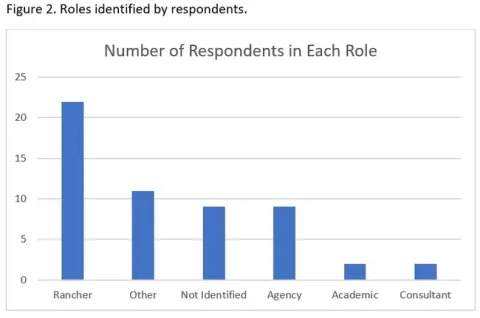
Question 3 was, “Are oaks on your ranch / in your area important to you: yes or no?” All, but one respondent said that oaks on their ranch or in their area are important. We also asked why oaks were, or were not, important to them (Figure 3 and Table 1). This was on open-ended question with no pre-defined answers, so people could write anything they chose. Several themes came up more than once. Responses identified in just one survey are not included here. The four most common responses were that oaks are important habitat, provide shade, are beautiful, and provide a host of other ecosystem services. Interestingly, nine people said that oaks are important because they represent California's natural and/or human heritage. A few people said oaks are important because they are old and are disappearing, provide erosion control, are native, and are used for firewood.
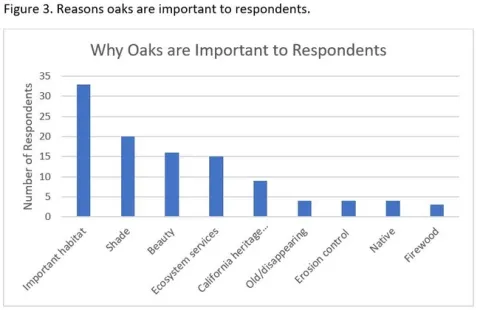
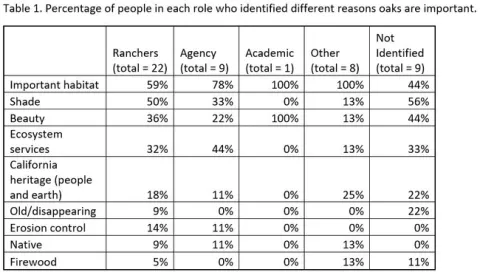
Question 4 was, “Which of these questions are most important to you?” There were three predetermined questions (Figure 4 and Table 2). Respondents were allowed to choose more than one option. Twenty-eight people wanted to know how they can prevent their oaks from dying. Twenty-seven respondents wanted to know how they can increase the number of oaks on their properties. And 18 wanted to know why their oaks are dying.
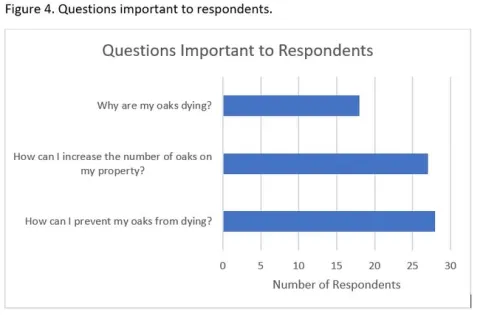

We also asked if there were other questions not listed that were important. See Appendix A, Table 1 for all additional questions that were important to respondents. Here are some of the responses:
- What do I do about too much sapling recruitment?
- Oak woodland recovery after wildland fire.
- How do I decide where best to plant oaks on my property, and which varieties?
- How do we have oaks and grazing?
- What was historic oak cover?
- Oak recruitment and mortality (demography; age distribution). Habitat conditions that promote oak recruitment. Blue oak and Valley oak.
- How can I easily census oaks, including age classes, and determine population viability and effective recruitment?
- Facilitating regeneration on landscape scales.
- Pruning to keep balance, prevent splitting or dropping large branches.
Question 5 was, “Which of these topics do you want to know more about?” Respondents were allowed to choose more than one of the pre-defined options. Invasive species on oak woodlands was the topic most people (37) wanted to know more about (Figure 5 and Table 3), followed by ecological site descriptions at 22 responses, and both carbon dynamics and climate change at 21 responses. Four people said they did not want more information about any of the listed topics.
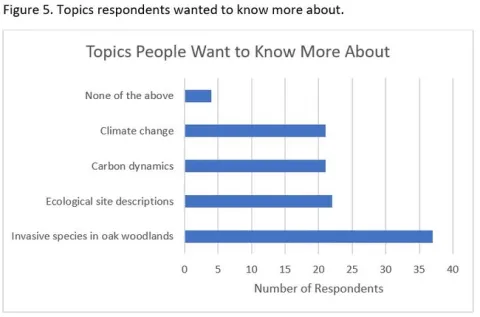

We also asked what other topics they wanted to know more about. See Appendix A, Table 2 for all additional topics respondents wanted to know more about. Here are some of the responses:
- Long-term population dynamics, prehistoric role of CA Indians in oak distribution
- How can oak management be directed to influence soil characteristics such as water infiltration rates, soil carbon, organic matter, bulk density and water holding capacity on rangelands?
- There are a number of somewhat recent pest threats, including disease and insects, that would be good to learn about, as well as, to understand the symptoms and where to take detection samples for analysis.
- Getting Native Californians more involved in management of their ancestral lands.
- Encouraging the NRCS and their partners to complete ESD's on MLRA's 15 and 17 would go far to facilitate planning and implementation of improved grazing management.
- I would like to know how the understory was managed a thousand years ago.
- I'd love to learn more about oak woodland habitat succession and the dynamics that interplay between associate species!
Question 6 was, “What questions do you need answers to regarding oak trees or oak woodlands?” This was on open-ended question with no pre-defined answers, so people could write anything they chose. Answers were wide ranging. See Appendix A, Table 3 for entire list of questions respondents need answers to regarding oak trees and oak woodlands. Here are some of the responses:
- The value of trimming and thinning in oak survival.
- How to get blue oaks started?
- What other than drought is killing the trees?
- What are the benefits, as well as negative consequences, of having heavily wooded areas (mainly oaks)?
- How can we support and/or encourage oak regeneration on rangelands? Are there passive management actions (i.e. planned grazing) that can facilitate oak regeneration or must we rely on active oak restoration via planting seedlings/acorns?
- Do livestock, primarily cattle, have an effect on oak mortality and if so can it be reduced by changing grazing patterns such as removing summer grazing. What effects do native herbivores have on young oaks?
- Where is oak restoration feasible under climate change projections?
- Vulnerability of oak habitats/ecosystems to climate change and other stressors.
- How can oak recruitment be facilitated on compacted rangeland soils?
Question 7 was, “What factors do you think influence oak mortality in your area?” There were three predetermined questions (Figure 6 and Table 4). Respondents were allowed to choose more than one option. Most people thought drought was influencing oak mortality in their areas, followed by disease and insect pests. Only 13 people chose “other” but 19 gave responses for other factors they think influence oak mortality.

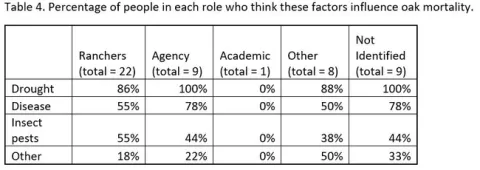
See Appendix A, Table 4 for all additional factors respondents think influence oak mortality in their areas. Here are some of the responses:
- Grazing management and its effect on the water cycle.
- The feral hogs do a lot of damage.
- All ecological factors interact (synergistic) to result in oak mortality.
- Competition from non-native grasses.
- Climate change, non-native annual grasses (young oaks), livestock browse (young oaks) and soil compaction (regeneration).
- Grazing upon oak seedlings.
- Mistletoe
On April 28 and 29 UCCE will hold our Oak Woodland Workgroup meeting at UC Berkeley to discuss potential research projects to begin addressing some of these issues.
Appendix A: Detailed Responses to Four Questions
|
Table 1: Question 4 - Additional questions that were important to respondents |
|
Rancher
|
|
Agency
|
|
Other
|
|
No role identified
|
|
Table 2: Question 5 - Other topics that people wanted to know more about |
|
Rancher
|
|
Agency
|
|
Academic
|
|
Other
|
|
Role not identified
|
|
Table 3: Question 6 - Questions people need answers to regarding oak trees or oak woodlands |
|
Rancher
|
|
Agency
|
|
Other
|
|
Role not identified
|
|
Table 4: Question 7 - Other factors that people think affect oak mortality |
|
Rancher
|
|
Agency
|
|
Other
|
|
Role not identified
|
